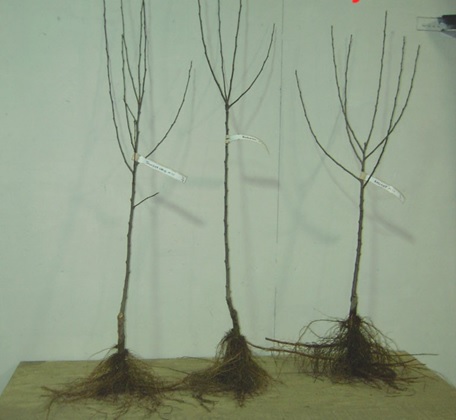 Deciduous Fruit Tree Chilling Requirements - December 5, 2018 Jeff Schalau, Agent, Agriculture & Natural Resources University of Arizona Cooperative Extension, Yavapai County This time of year, many gardeners are contemplating which deciduous fruit tree varieties they should purchase. New varieties become available over time and the catalogs tempt gardeners with irresistible descriptions. Before choosing a fruit tree variety, you should know something about chilling requirements, how they are used to select appropriate fruit tree varieties. Deciduous fruit trees need a certain amount of winter chilling to break down growth inhibitors in flower and vegetative buds. Many nurseries provide an estimate of the chilling requirement (also called chill hours) needed for the tree to be success in a given climate regime. Varieties vary by chilling requirement and varieties are recommended based on the "average" number of winter chill hours a given area receives on average during the winter dormant season. The classic definition of chilling requirement is the number of hours the temperature is below 45 degrees F and above 32 degrees F. More recently, it has been suggested that hours above 65 degrees F be subtracted from the previous calculation. While it sounds feasible at first, the National Weather Service does not routinely calculate and publish these statistics. To further complicate this issue, there are many horticulturists whom are in the process of rethinking how chilling requirements should be calculated. Given all this difficulty and disagreement, the fruit trees themselves are usually very forgiving. The real trick is to know that there is a chilling requirement and what is the appropriate “ballpark” figure for your area. There are some observable symptoms to look for in fruit trees that have chilling hours incompatible with the local climate. Fruit trees with a lower chilling requirement than necessary frequently experience crop loss due to early bloom and late spring frost damages the crop. In these situations, the chilling requirement was exceeded. Conversely, planting varieties with higher chilling requirements than required can result in uneven bloom and/or delayed foliation. In these cases, the chilling requirement was not met. Remember chilling requirements are based on averages and calculated averages are made up from extremes and each chilling requirement has some latitude. After searching for new information on this inexact topic, I found no reliable new information for Arizona. So based on experience, I provide some ranges of chilling requirements for most areas of Yavapai County by elevation range. For elevations above 6,000 ft, look for varieties with chilling requirements above 1,000 hours. For elevations between 4,000 and 6,000 ft, look for varieties with chilling requirements between 750 and 1,000 hours. For elevations between 2,500 and 4,000 ft, look for varieties with chilling requirements between 500 and 750 hours. Remember, you probably have some flexibility here depending on your orchard site/microclimate. Remember that stone fruits (peaches, apricots, cherries, plums, etc.) are typically earlier to bloom than pome-type fruits (apple, pear, quince) and will produce crops less frequently in areas prone to late spring freezes. In addition, fruit varieties are also advertised as having either early, midseason, or late season bloom periods. For best results, talk to neighbors, visit with reputable fruit growers, or visit your local Cooperative Extension office for additional information. Always buy high quality fruit trees from reliable sources. I have always preferred bare root trees over container grown fruit trees. I only know of one nursery in Yavapai County that still stocks bare root deciduous fruit trees for retail sale. This is The Native Garden in Prescott, AZ. Some mail order or online sources will also ship direct to consumers for planting in the early spring. Bare root trees packaged in small plastic bags from big box stores are not recommended. These trees are often sold without listing the chilling requirement and may have been on the shelf for an extended period. When purchasing a fruit tree, look at the labels or packaging to find the chilling requirement for that variety. High-quality trees often tell you the fruit variety, the chilling requirement, and which rootstock the tree is grafted to. You can ask the nurseryperson to assist you in locating this information. The online edition includes links to additional information including fruit tree varieties and their chilling requirements. Naming of businesses, companies or products is neither meant to imply endorsement by the author nor criticism of similar companies or products not mentioned. Follow the Backyard Gardener on Twitter – use the link on the BYG website. If you have other gardening questions, call the Master Gardener help line in the Camp Verde office at 928-554-8992 or e-mail us at verdevalleymg@gmail.com and be sure to include your name, address and phone number. Find past Backyard Gardener columns or provide feedback at the Backyard Gardener web site: http://cals.arizona.edu/yavapai/anr/hort/byg/. Photos  Peaches growing in Chino Valley, Arizona (Photo by Jeff Schalau).
Peaches growing in Chino Valley, Arizona (Photo by Jeff Schalau). Dormant bare root fruit trees showing healthy root systems.
Dormant bare root fruit trees showing healthy root systems.Additional Information Backyard Fruit Production at Elevations 3,500 to 6,000 Feet University of Arizona Cooperative Extension extension.arizona.edu/sites/extension.arizona.edu/files/pubs/az1162-2015.pdf Fruit Tree Chilling Requirement Dave Wilson Nursery www.davewilson.com/product-information-general/special-topics/fruit-tree-chilling-requirement Dave Wilson Nursery Fruit Tree Varieties Listings of varieties and their chilling requirements. www.davewilson.com/product-information/category/fruit-trees |